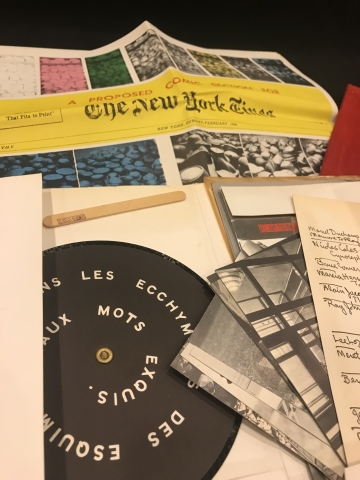S.M.S., No. 2
Category: Preserve for the Future
Location: Hirshhorn Museum and Sculpture Garden Library
S.M.S., No. 2, April 1968
The S.M.S. portfolios were a collaboration between late Surrealist artists William Copley (friends with and gallerist to Dada artists Man Ray, Duchamp, Max Ernst, etc.) and Dmitri Petrov, which they published through their Letter Edged in Black Press. The project involved some of the most important artists of the twentieth century, and exemplified the community ethos of the 1960s. Both the Dada movement, and the Fluxus movement that followed it, did not agree with the authority of museums to determine the value of art, nor did they believe that one must be educated to view and understand a piece of art. S.M.S., or “Shit Must Stop,” bypassed traditional institutions to distribute artists’ work directly to their audience. Six portfolios containing eleven to thirteen objects were produced in editions of 2000. Ironically, today these works are highly valued and prized by museum collections.
Published in April 1968, the second publication of S.M.S. features a seven minute recording by Marcel Duchamp of contrapetrie, a surrealist word game; an intimate photo-album in lush red velvet by Clovis Trouille; printed money created by Bruce Connor; a debossed print by Meret Oppenheimer; and a proposed comic for the New York Times by Bernard Pfreim. The Hirshhorn Library will be the recipient of Barbara and Aaron Levine's research collection on Marcel Duchamp, aligning the Hirshhorn as a future center for Duchamp and surrealist studies. This issue of S.M.S. fits well in the collection.
This is a mid 20th century artists portfolio housed in the original portfolio that is in a pre-made cardboard box. The portfolio consists of elements created by eleven different artists. These include a popsicle stick and an album bound in red velvet. Conservators will create separate housing for each of the items. These will include Mylar L-sleeves, acid free enclosures, and a large double-tray box to house all of the elements together.
Discover more about this book in our Catalog.

